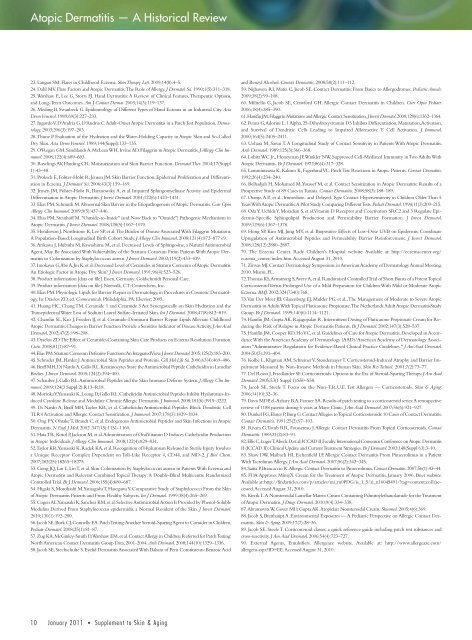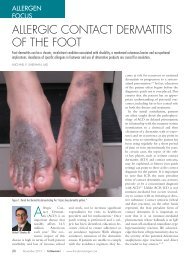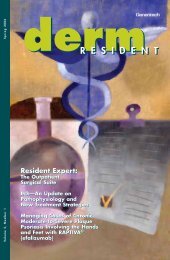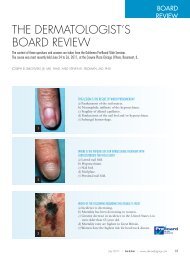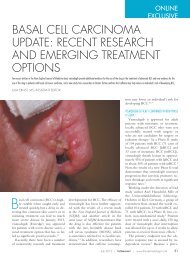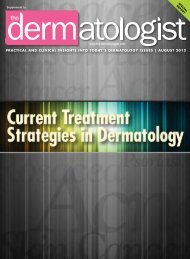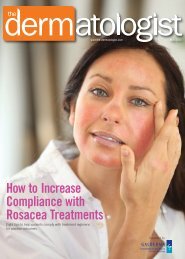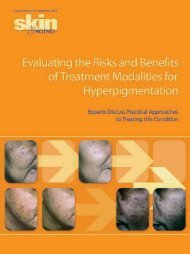TREATING ATOPIC DERMATITIS: - The Dermatologist
TREATING ATOPIC DERMATITIS: - The Dermatologist
TREATING ATOPIC DERMATITIS: - The Dermatologist
You also want an ePaper? Increase the reach of your titles
YUMPU automatically turns print PDFs into web optimized ePapers that Google loves.
Atopic Dermatitis — A Historical Review<br />
23. Langan SM. Flares in Childhood Eczema. Skin <strong>The</strong>rapy Lett. 2009;14(8):4–5.<br />
24. Dahl MV. Flare Factors and Atopic Dermatitis: <strong>The</strong> Role of Allergy. J Dermatol Sci. 1990;1(5):311–318.<br />
25. Warshaw E, Lee G, Storrs FJ. Hand Dermatitis: A Review of Clinical Features, <strong>The</strong>rapeutic Options,<br />
and Long-Term Outcomes. Am J Contact Dermat. 2003;14(3):119–137.<br />
26. Meding B, Swanbeck G. Epidemiology of Different Types of Hand Eczema in an Industrial City. Acta<br />
Derm Venereol. 1989;69(3):227–233.<br />
27. Ingordo V, D'Andria G, D'Andria C. Adult-Onset Atopic Dermatitis in a Patch Test Population. Dermatology.<br />
2003;206(3):197–203.<br />
28. Thune P. Evaluation of the Hydration and the Water-Holding Capacity in Atopic Skin and So-Called<br />
Dry Skin. Acta Derm Venereol. 1989;144(Suppl):133–135.<br />
29. O'Regan GM, Sandilands A, McLean WH, Irvine AD. Filaggrin in Atopic Dermatitis. J Allergy Clin Immunol.<br />
2008;122(4):689–693.<br />
30. Rawlings AV, Harding CR. Moisturization and Skin Barrier Function. Dermatol <strong>The</strong>r. 2004;17(Suppl<br />
1):43–48.<br />
31. Proksch E, Folster-Holst R, Jensen JM. Skin Barrier Function, Epidermal Proliferation and Differentiation<br />
in Eczema. J Dermatol Sci. 2006;43(3):159–169.<br />
32. Jensen JM, Fölster-Holst R, Baranowsky A, et al. Impaired Sphingomyelinase Activity and Epidermal<br />
Differentiation in Atopic Dermatitis. J Invest Dermatol. 2004;122(6):1423–1431.<br />
33. Elias PM, Schmuth M. Abnormal Skin Barrier in the Etiopathogenesis of Atopic Dermatitis. Curr Opin<br />
Allergy Clin Immunol. 2009;9(5):437–446.<br />
34. Elias PM, Steinhoff M. "Outside-to-Inside" (and Now Back to "Outside") Pathogenic Mechanisms in<br />
Atopic Dermatitis. J Invest Dermatol. 2008;128(5):1067–1070.<br />
35. Henderson J, Northstone K, Lee SP, et al. <strong>The</strong> Burden of Disease Associated With Filaggrin Mutations:<br />
A Population-Based, Longitudinal Birth Cohort Study. J Allergy Clin Immunol. 2008;121(4):872–877 e9.<br />
36. Arikawa J, Ishibashi M, Kawashima M, et al. Decreased Levels of Sphingosine, a Natural Antimicrobial<br />
Agent, May Be Associated With Vulnerability of the Stratum Corneum From Patients With Atopic Dermatitis<br />
to Colonization by Staphylococcus aureus. J Invest Dermatol. 2002;119(2):433–439.<br />
37. Imokawa G, Abe A, Jin K, et al. Decreased Level of Ceramides in Stratum Corneum of Atopic Dermatitis:<br />
An Etiologic Factor in Atopic Dry Skin? J Invest Dermatol. 1991;96(4):523–526.<br />
38. Product information [data on file]. Essen, Germany: Goldschmidt Personal Care.<br />
39. Product information [data on file]. Norwalk, CT: Centerchem, Inc.<br />
40. Elias PM. Physiologic Lipids for Barrier Repair in Dermatology, in Procedures in Cosmetic Dermatology.<br />
In: Draelos ZD, ed. Cosmeceuticals. Philadelphia, PA: Elsevier; 2005.<br />
41. Huang HC, Chang TM. Ceramide 1 and Ceramide 3 Act Synergistically on Skin Hydration and the<br />
Transepidermal Water Loss of Sodium Lauryl Sulfate-Irritated Skin. Int J Dermatol. 2008;47(8):812–819.<br />
42. Chamlin SL, Kao J, Frieden IJ, et al. Ceramide-Dominant Barrier Repair Lipids Alleviate Childhood<br />
Atopic Dermatitis: Changes in Barrier Function Provide a Sensitive Indicator of Disease Activity. J Am Acad<br />
Dermatol. 2002;47(2):198–208.<br />
43. Draelos ZD. <strong>The</strong> Effect of Ceramide-Containing Skin Care Products on Eczema Resolution Duration.<br />
Cutis. 2008;81(1):87–91.<br />
44. Elias PM. Stratum Corneum Defensive Functions: An Integrated View. J Invest Dermatol. 2005;125(2):183–200.<br />
45. Schroder JM, Harder J. Antimicrobial Skin Peptides and Proteins. Cell Mol Life Sci. 2006;63(4):469–486.<br />
46. Braff MH, Di Nardo A, Gallo RL. Keratinocytes Store the Antimicrobial Peptide Cathelicidin in Lamellar<br />
Bodies. J Invest Dermatol. 2005;124(2):394–400.<br />
47. Schauber J, Gallo RL. Antimicrobial Peptides and the Skin Immune Defense System. J Allergy Clin Immunol.<br />
2009;124(3 Suppl 2):R13–R18.<br />
48. Morioka Y, Yamasaki K, Leung D, Gallo RL. Cathelicidin Antimicrobial Peptides Inhibit Hyaluronan-Induced<br />
Cytokine Release and Modulate Chronic Allergic Dermatitis. J Immunol. 2008;181(6):3915–3222.<br />
49. Di Nardo A, Braff MH, Taylor KR, et al. Cathelicidin Antimicrobial Peptides Block Dendritic Cell<br />
TLR4 Activation and Allergic Contact Sensitization. J Immunol. 2007;178(3):1829–1834.<br />
50. Ong PY, Ohtake T, Brandt C, et al. Endogenous Antimicrobial Peptides and Skin Infections in Atopic<br />
Dermatitis. N Engl J Med. 2002. 347(15):1151–1160.<br />
51. Hata TR, Kotol P, Jackson M, et al. Administration of Oral Vitamin D Induces Cathelicidin Production<br />
in Atopic Individuals. J Allergy Clin Immunol. 2008;122(4):829–831.<br />
52. Taylor KR, Yamasaki K, Radek KA, et al. Recognition of Hyaluronan Released in Sterile Injury Involves<br />
a Unique Receptor Complex Dependent on Toll-Like Receptor 4, CD44, and MD-2. J Biol Chem.<br />
2007;282(25):18265–18275.<br />
53. Gong JQ, Lin L, Lin T, et al. Skin Colonization by Staphylococcus aureus in Patients With Eczema and<br />
Atopic Dermatitis and Relevant Combined Topical <strong>The</strong>rapy: A Double-Blind Multicentre Randomized<br />
Controlled Trial. Br J Dermatol. 2006;155(4):680–687.<br />
54. Higaki S, Morohashi M, Yamagishi T, Hasegawa Y. Comparative Study of Staphylococci From the Skin<br />
of Atopic Dermatitis Patients and From Healthy Subjects. Int J Dermatol. 1999;38(4):265–269.<br />
55. Cogen AL, Yamasaki K, Sanchez KM, et al. Selective Antimicrobial Action Is Provided by Phenol-Soluble<br />
Modulins Derived From Staphylococcus epidermidis, a Normal Resident of the Skin. J Invest Dermatol.<br />
2010;130(1):192–200.<br />
56. Jacob SE, Burk CJ, Connelly EA. Patch Testing: Another Steroid-Sparing Agent to Consider in Children.<br />
Pediatr Dermatol. 2008;25(1):81–87.<br />
57. Zug KA, McGinley-Smith D, Warshaw EM, et al. Contact Allergy in Children Referred for Patch Testing:<br />
North American Contact Dermatitis Group Data, 2001-2004. Arch Dermatol. 2008;144(10):1329–1336.<br />
58. Jacob SE, Stechschulte S. Eyelid Dermatitis Associated With Balsam of Peru Constituents: Benzoic Acid<br />
and Benzyl Alcohol. Contact Dermatitis. 2008;58(2):111–112.<br />
59. Nijhawen RI, Matiz C, Jacob SE. Contact Dermatitis: From Basics to Allergodromes. Pediatric Annals.<br />
2009;38(2):99–108.<br />
60. Militello G, Jacob SE, Crawford GH. Allergic Contact Dermatitis in Children. Curr Opin Pediatr.<br />
2006;18(4):385–390.<br />
61. Hanifin JM. Filaggrin Mutations and Allergic Contact Sensitization. J Invest Dermatol. 2008;128(6):1362–1364.<br />
62. Penna G, Adorini L. 1 Alpha, 25-Dihydroxyvitamin D3 Inhibits Differentiation, Maturation, Activation,<br />
and Survival of Dendritic Cells Leading to Impaired Alloreactive T Cell Activation. J Immunol.<br />
2000;164(5):2405–2411.<br />
63. Uehara M, Sawai T. A Longitudinal Study of Contact Sensitivity in Patients With Atopic Dermatitis.<br />
Arch Dermatol. 1989;125(3):366–368.<br />
64. Lobitz WC Jr., Honeyman JF, Winkler NW. Suppressed Cell-Mediated Immunity in Two Adults With<br />
Atopic Dermatitis. Br J Dermatol. 1972;86(4):317–328.<br />
65. Lammintausta K, Kalimo K, Fagerlund VL. Patch Test Reactions in Atopic Patients. Contact Dermatitis.<br />
1992;26(4):234–240.<br />
66. Belhadjali H, Mohamed M, Youssef M, et al. Contact Sensitization in Atopic Dermatitis: Results of a<br />
Prospective Study of 89 Cases in Tunisia. Contact Dermatitis. 2008;58(3):188–189.<br />
67. Oranje, A.P., et al., Immediate- and Delayed-Type Contact Hypersensitivity in Children Older Than 5<br />
Years With Atopic Dermatitis: A Pilot Study Comparing Different Tests. Pediatr Dermatol. 1994;11(3):209–215.<br />
68. Oda Y, Uchida Y, Moradian S, et al. Vitamin D Receptor and Coactivators SRC2 and 3 Regulate Epidermis-Specific<br />
Sphingolipid Production and Permeability Barrier Formation. J Invest Dermatol.<br />
2009;129(6):1367–1378.<br />
69. Hong SP, Kim MJ, Jung MY, et al. Biopositive Effects of Low-Dose UVB on Epidermis: Coordinate<br />
Upregulation of Antimicrobial Peptides and Permeability Barrier Reinforcement. J Invest Dermatol.<br />
2008;128(12):2880–2887.<br />
70. <strong>The</strong> Eczema Center. Rady Children’s Hospital website. Available at: http://eczemacenter.org/<br />
eczema_center/index.htm. Accessed August 31, 2010.<br />
71. Zirwas MJ. Contact Dermatology Symposium. in American Academy of Dermatology Annual Meeting.<br />
2010. Miami, FL.<br />
72. Thomas KS, Armstrong S, Avery A, et al. Randomised Controlled Trial of Short Bursts of a Potent Topical<br />
Corticosteroid Versus Prolonged Use of a Mild Preparation for Children With Mild or Moderate Atopic<br />
Eczema. BMJ. 2002;324(7340):768.<br />
73. Van Der Meer JB, Glazenburg EJ, Mulder PG, et al., <strong>The</strong> Management of Moderate to Severe Atopic<br />
Dermatitis in Adults With Topical Fluticasone Propionate. <strong>The</strong> Netherlands Adult Atopic DermatitisStudy<br />
Group. Br J Dermatol. 1999;140(6):1114–1121.<br />
74. Hanifin JM, Gupta AK, Rajagopalan R. Intermittent Dosing of Fluticasone Propionate Cream for Reducing<br />
the Risk of Relapse in Atopic Dermatitis Patients. Br J Dermatol. 2002;147(3):528–537.<br />
75. Hanifin JM, Cooper KD, Ho VC, et al. Guidelines of Care for Atopic Dermatitis, Developed in Accordance<br />
With the American Academy of Dermatology (AAD)/American Academy of Dermatology Association<br />
"Administrative Regulations for Evidence-Based Clinical Practice Guidelines." J Am Acad Dermatol.<br />
2004;50(3):391–404.<br />
76. Kolbe L, Kligman AM, Schreiner V, Stoudemayer T. Corticosteroid-Induced Atrophy and Barrier Impairment<br />
Measured by Non-Invasive Methods in Human Skin. Skin Res Technol. 2001;7(2):73–77.<br />
77. Del Rosso J, Friedlander SF. Corticosteroids: Options in the Era of Steroid-Sparing <strong>The</strong>rapy. J Am Acad<br />
Dermatol. 2005;53(1 Suppl 1):S50–S58.<br />
78. Jacob SE, Steele T. Focus on the Non-T.R.U.E. Test Allergen — Corticosteroids. Skin & Aging.<br />
2006;14(10):32–36.<br />
79. Davis MDP, el-Azhary RA, Farmer SA. Results of patch testing to a corticosteroid series: A retrospective<br />
review of 1188 patents during 6 years at Mayo Clinic. J Am Acad Dermatol. 2007;56(6):921–927.<br />
80. Dunkel FG, Elsner P, Burg G. Contact Allegies to Topical Corticosteroids: 10 Cases of Contact Dermatitis.<br />
Contact Dermatitis. 1991;25(2):97–103.<br />
81. Rivara G, Tomb RR, Foussereau J. Allergic Contact Dermatitis From Topical Corticosteroids. Contact<br />
Dermatitis. 1989;21(2):83–91.<br />
82. Ellis C, Luger T, Abeck D, et al; ICCAD II Faculty. International Consensus Conference on Atopic Dermatitis<br />
II (ICCAD II): Clinical Update and Current Treatment Strategies. Br J Dermatol. 2003;148(Suppl 63):3–10.<br />
83. Shaw DW, Maibach HI, Eichenfield LF. Allergic Contact Dermatitis From Pimecrolimus in a Patient<br />
With Tacrolimus Allergy. J Am Acad Dermatol. 2007;56(2):342–345.<br />
84. Saitta P, Brancaccio R. Allergic Contact Dermatitis to Pimecrolimus. Contact Dermatitis. 2007;56(1):43–44.<br />
85. FDA Approves MimyX Cream for the Treatment of Atopic Dermatitis. January 2006. Bnet website.<br />
Available at: http://findarticles.com/p/articles/mi_m0PDG/is_1_5/ai_n16045491/?tag=content;col1(accessed.<br />
Accessed August 31, 2010.<br />
86. Kircik L. A Nonsteroidal Lamellar Matrix Cream Containing Palmitoylethanolamide for the Treatment<br />
of Atopic Dermatitis. J Drugs Dermatol. 2010;9(4):334–338.<br />
87. Abramovits W, Gover MD, Gupta AK. Atopiclair Nonsteroidal Cream. Skinmed. 2005;4(6):369.<br />
88. Jacob S, Breithaupt A. Environmental Exposures — A Pediatric Perspective on Allergic Contact Dermatitis.<br />
Skin & Aging. 2009;17(7):28–36.<br />
89. Jacob SE, Steele T. Corticosteroid classes: a quick reference guide including patch test substances and<br />
cross-reactivity. J Am Acad Dermatol. 2006;54(4):723–727.<br />
90. External Agents, Emulsifiers. Allergeaze website. Available at: http://www.allergeaze.com/<br />
allergens.aspx?ID=EE. Accessed August 31, 2010.<br />
10 Januar y 2011 ◆ Supplement to Skin & Aging


